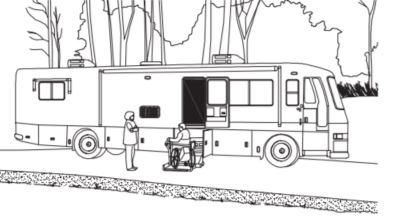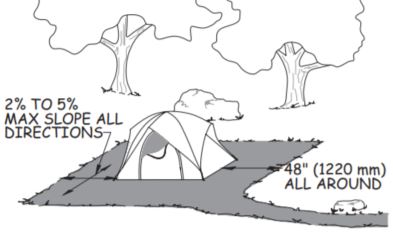Outdoor Developed Areas: A Summary of Accessibility Standards for Federal Outdoor Developed Areas
Camping Facilities
Definition [F106.5]

A camping facility is a site, or a portion of a site, that is developed for outdoor recreational purposes and contains camping units.
A camping unit is an outdoor space in a camping facility that is used for camping and contains outdoor constructed features, parking spaces for RVs or other vehicles, tent pads or tent platforms, or camp shelters.
Camping Units With Mobility Features [F244.2]
Camping facilities must provide a minimum number of camping units with mobility features based on the total number of camping units provided in the camping facility, in accordance with table 5. When different types of camping units are provided (e.g., camping units for RVs only or tent camping only, or camping units with camp shelters), table 5 applies to each type of camping unit provided. If a camping facility has 15 units for tent camping only and 30 units for RVs only, then at least two of the tent camping units and at least three of the RV units must provide mobility features.
| Total Number of Camping Units Provided in Camping Facility | Minimum Required Number of Camping Units with Mobility Features |
|---|---|
| 1 | 1 |
| 2 to 25 | 2 |
| 26 to 50 | 3 |
| 51 to 75 | 4 |
| 76 to 100 | 5 |
| 101 to 150 | 7 |
| 151 to 200 | 8 |
| 201 and over | 8, plus 2 percent of the number over 200 |
Camping units with mobility features don’t have to be identified by signs. Entities should provide information on the location of camping units with mobility features on Web sites, in brochures, and at bulletin boards or information kiosks at the camping facility. When an entity operates a reservation system for camping units or assigns camping units upon arrival, the entity should establish policies and procedures to ensure that camping units with mobility features are available for people with disabilities until all other camping units are occupied.
Alterations and Additions [F244.2.1]

When altering or adding camping units at an existing camping facility, only consider the number of altered or added camping units when using table 5 to determine the required number of camping units with mobility features. Continue this practice whenever camping units are altered or added until the total number of camping units with mobility features in the camping facility complies with the minimum number required in table 5.
Example
A camping facility has 50 RV camping units. The facility currently does not have an RV camping unit with mobility features. Twenty-five additional RV units are being added to the facility. With the addition of 25 new units, 2 of the newly added units are required to have mobility features even though, in new construction, 75 new units would require 4 units with mobility features to be provided. The scoping requirements apply to any subsequent alteration or addition until the full number of units with mobility features required on a site is satisfied.
When an entity is implementing a transition plan for program accessibility developed pursuant to regulations issued under section 504 of the Rehabilitation Act, which designates specific camping units to provide mobility features, the entity is not required to provide accessible elements when altering individual elements within camping units that are not designated to provide mobility features. When all the elements within a camping unit are altered, the altered camping unit must provide mobility features unless the minimum number of camping units with mobility features required in table 5 is already provided at the camping facility.
Dispersion [F244.2.2]
Camping units with mobility features must provide choices of units comparable to and integrated with those available to all other campers. For instance, if camping units are provided near a body of water or on the foothills, then some units with mobility features must also be located in the same settings.
Elements Within Camping Units With Mobility Features [F244.2.3]
At least one of each type of element provided within camping units with mobility features, including outdoor constructed features, parking spaces for RVs, parking spaces for vehicles other than RVs, tent pads and tent platforms, and camp shelters, must comply with the applicable technical requirements for the element. When more than one of the same type of element (e.g., picnic tables, tent pads) is provided within a camping unit with mobility features, at least two of the same type of element must comply with the applicable technical requirements for the element.
Outdoor Constructed Features in Common Use and Public Use Areas [F244.3]
Where outdoor constructed features are provided in common use and public use areas that serve camping units with mobility features, at least 20 percent, but no less than one, of each type of outdoor constructed feature provided at each location must comply with the applicable technical requirements for the feature.
Outdoor Recreation Access Routes in Camping Facilities [F244.5]
The scoping and technical requirements for ORARs in camping facilities are discussed in the section of this guide on ORARs.
RV Parking Spaces Within Camping Units With Mobility Features and RV Pull-Up Spaces at Dump Stations [F244.2.3.2.1 and F244.4]

RV parking spaces within camping units with mobility features and RV pull-up spaces at dump stations must comply with the technical requirements for width, surface, and slope of RV spaces.
Width of Spaces [1012.2]
Parking spaces and pull-up spaces for RVs must be at least 20 feet wide to accommodate RVs equipped with a lift (figure 27). RVs are typically 8 feet wide and require a 9-foot-wide space. RVs equipped with a lift need an additional 8 feet of space on the passenger’s side to deploy the lift and to allow people using mobility devices to maneuver onto and off of the lift. Utility hookups for RVs are typically located on the driver’s side of the vehicle. An additional 3 feet of space is needed on the driver’s side so that people using mobility devices can access the utility hookups.
Where two adjacent parking spaces are provided for RVs, one of the parking spaces is permitted to be narrower, but must be at least 16 feet wide.

Figure 27—An accessible recreational vehicle with a wheelchair lift.
Surface and Slope [1012.4 and 1012.5]
The surface of parking spaces and pull-up spaces for RVs must be firm and stable.
When the surface of parking spaces and pull-up spaces for RVs is constructed of asphalt, concrete, or boards, the slope of the parking spaces and pull-up spaces must be no steeper than 1:48 (2 percent) in any direction. When the surface of parking spaces and pull-up spaces for RVs is constructed of materials other than asphalt, concrete, or boards, slopes no steeper than 1:20 (5 percent) are allowed when necessary for drainage.
Parking Spaces for Vehicles Other Than RVs [F244.2.3.2.2]

Parking spaces for vehicles other than RVs within camping units with mobility features must comply with the following technical requirements for width, surface, and slope.
Width of Spaces [1012.3]
Parking spaces for vehicles other than RVs must be at least 16 feet wide. Parking spaces at least 16 feet wide can accommodate vans equipped with a lift or ramp.
When two adjacent parking spaces are provided for vehicles other than RVs, one of the parking spaces is permitted to be at least 8 feet wide.
Parking spaces within camping units with mobility features do not have to be striped or identified by the International Symbol of Accessibility.
Surface and Slope [1012.4 and 1012.5]
The technical requirements for the surface and slope of parking spaces for vehicles other than RVs are the same as for RV parking spaces.
Tent Pads and Tent Platforms [1013]

Tent pads and tent platforms are defined spaces with prepared surfaces for setting up and securing tents. No minimum tent pad size is specified because the types of tents commonly used in camping facilities can vary depending on the setting. For example, small tents may be used at a camping facility near a wilderness access point, while large family tents may be used at a more developed camping facility with numerous constructed features. Tent pads and tent platforms must comply with the technical requirements for clear ground space and slope. Tent platforms must also comply with the technical requirements for height.
Exception [1013.1, Exception]
When a condition for exception does not permit full compliance with a specific provision in the technical requirements for tent pads and tent platforms, the tent pads and tent platforms must comply with the specific provision to the extent practicable. Additional information on the conditions for exceptions is provided in the section of this guide on the conditions for exceptions.
Clear Ground Space [1013.2]
A clear ground space at least 48 inches wide must be provided on all usable sides of tent pads and tent platforms. This clear ground space enables people using mobility devices to set up and take down a tent (figure 28). The usable sides of tent pads and tent platforms are the sides that can be used for setting up and taking down a tent. All sides of tent pads and tent platforms are generally usable, unless the tent pad or tent platform is located next to a natural feature, such as a rock or tree, that renders a side unusable. The surface of the clear ground space must be firm and stable, but must also accommodate the use of tent stakes or other devices to secure the tent.

Figure 28—Clear space requirements for tent pads and platforms.
Slope [1013.3]
When the surface of tent pads, tent platforms, and clear ground spaces is constructed of materials other than asphalt, concrete, or boards, the surface must be no steeper than 1:48 (2 percent) in any direction. When the surface is constructed of materials other than asphalt, concrete, or boards, slopes no steeper than 1:20 (5 percent) are allowed when necessary for drainage.
Floor Height [1013.4]
If the tent platform floor is raised above grade, the floor height must be no more than 19 inches when measured from the clear ground space to the tent platform surface. This height allows people using mobility devices to transfer from the device to the platform surface.
Definition [F106.5]

A camp shelter is a partially enclosed structure that provides campers and hikers cover from weather and that does not contain plumbing fixtures or kitchen appliances. Camp shelters are often located on long-distance trails. Camp shelters are not cabins, which are typically larger and must comply with the ABA Standards for transient lodging.
Exceptions [1014.1, Exceptions 1 and 2]
When a condition for exception does not permit full compliance with a specific provision in the technical requirements for camp shelters, the camp shelter must comply with the specific provision to the extent practicable. Additional information on the conditions for exceptions is provided in the section of this guide on the conditions for exceptions.
The technical requirements for protruding objects in section 309 of the ABA Standards do not apply to camp shelters. Many times, the roof of a camp shelter is sloped or does not permit someone to stand fully erect while in the shelter.
Entrance [1014.2]
Camp shelters must provide either transfer access or roll-in access at the entrance. Providing shelters with roll-in access enables people using mobility devices to also shelter the device.
Transfer Access [1014.2.1]
To provide transfer access at the entrance to a camp shelter, a clear ground space at least 36 by 48 inches positioned for a parallel approach must be provided along the open side of the camp shelter. One full, unobstructed side of the clear ground space must adjoin or overlap an ORAR or trail, as applicable, or another clear ground space. The surface of the clear ground space must be firm and stable. When the surface of the clear ground space is constructed of asphalt, concrete, or boards, the slope of the clear ground space must be no steeper than 1:48 (2 percent) in any direction. When the surface of the clear ground space is constructed of materials other than asphalt, concrete, or boards, slopes no steeper than 1:20 (5 percent) are allowed when necessary for drainage.
The camp shelter floor at the entrance or opening must be no higher than 19 inches when measured from the clear ground space. This enables people using mobility devices to pull alongside of the shelter and transfer from the mobility device to the shelter floor. For people using power mobility devices, raised floor shelters that provide transfer access may make it difficult to bring the mobility device into the shelter to protect it from the weather.
Roll-in Access [1014.2.2]
To provide roll-in access into a camp shelter, a level or sloped entry route that complies with the technical requirements for an ORAR or trail, as applicable, must be provided along the open side of the camp shelter. Handrails and edge protection are not required on a sloped entry into a camp shelter but may be useful to people with and without disabilities.
When roll-in access is provided, a turning space at least 60 inches in diameter or a T-shaped space with an arm at least 60 by 36 inches and a base at least 36 inches wide and 24 inches long must be provided inside the camp shelter.
Floor [1014.3]
The floor surface within a camp shelter must be firm and stable. When the floor surface is constructed of asphalt, concrete, or boards, the slope of the floor surface must be no steeper than 1:48 (2 percent) in any direction, regardless of the type of access provided (e.g., sloped entry or transfer access). When the floor surface is constructed of materials other than asphalt, concrete, or boards, slopes no steeper than 1:20 (5 percent) are allowed when necessary for drainage.

User Comments/Questions
Add Comment/Question